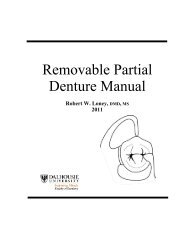Manuals_files/CD Manual 12.pdf - Removable Prosthodontics
Manuals_files/CD Manual 12.pdf - Removable Prosthodontics
Manuals_files/CD Manual 12.pdf - Removable Prosthodontics
Create successful ePaper yourself
Turn your PDF publications into a flip-book with our unique Google optimized e-Paper software.
Selecting & Setting Teeth - 43<br />
- Use the Portrait Shade number and not the Vita shade code when prescribing denture<br />
teeth from the Portrait shade guide. (Portrait numbers begin with a "P" and are listed<br />
as the bottom-most shade code on the shade tabs)<br />
- Anterior and posterior tooth shades are the same (e.g. anterior shade P3.5 corresponds<br />
with posterior shade P3.5)<br />
- Shade selection for porcelain restorations should be made with the Vita shade guides<br />
- If you need to match a porcelain restoration to denture teeth, select the Vita shade for<br />
porcelain and pick the corresponding Portrait shade (P1-P34) for theVita shade (the<br />
Vita shades are listed on the top of the Portrait shade tabs )<br />
- The patient should choose the shade guided by the dentist – if they want the whitest<br />
teeth possible, offer your opinion, don't persuade<br />
- Use the squint test for value (brightness) - squinting reduces the influence of hue - if the<br />
teeth look too bright while squinting, suggest something less bright<br />
Material<br />
- Porcelain teeth are becoming less prevalent<br />
- Acrylic much easier to set and adjust; they will last life of denture (5-7 years)<br />
Porcelain<br />
Acrylic<br />
- wear less - new materials wear well<br />
- more translucent - better teeth have layers to improve transluc.<br />
- brittle - fracture easily if dropped - resilient - acts as shock absorber<br />
- don't bond to base (stain, fall out) - chemically bonds to base<br />
- difficult to adjust/set - quieter; gum sticks<br />
Selecting Posterior Teeth Form (shape of the posterior teeth)<br />
Anatomic (40 °, 30°, 20°(semi-anatomic), 10°)<br />
- More esthetically pleasing (especially in the premolar region) – use for patients with<br />
esthetic concerns, if there are no contraindications (severe ridge resorption, jaw<br />
malrelations, uncoordinated jaw movement)<br />
- Use when a balanced occlusion is desired – they are easier to balance. Select a tooth<br />
cusp angle similar to the condylar inclination<br />
- Use when coordinated jaw movements are present















